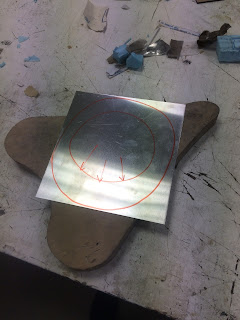Reflection
As a construction management student in my final year of study, there are very few instances where we are required to design; merely look at management techniques and investigate construction methodology. We are in the age of technology, computers have never been more influential and construction is not just seen as the end product, but is rather interspersed with design through BIM and ECI, as one example. For this reason it's of crucial importance for interdisciplinary relationships to flourish to deliver a superior product to the client in a very competitive environment.
Continuing on from the bowl tutorial, it's important to see how this structure fits into the design and construction space. The bowl is spherical in shape, uniform in profile and traditional in design. It's formed by aluminium, a material common in construction (framing), and in my opinion, a material which exemplifies that raw material, industrial style. I have selected four construction related structures to situate my bowl with, and a small explanation following.
National Centre for the Performing Arts, China
Often referred to as the 'Giant Egg', the facade of this building is constructed with primarily titanium and glass. The centre is unique as it plays off the reflection of the building on the man-made lake to give the illusion of completeness. The egg shape is traditionally very strong and distributes the external forces along the shell to the ground. The concave-d shadow is representative of the bowl, with the titanium shell similar in appearance to the aluminium.
Aldar Properties Headquarters, Abu Dhabi
The first round building in the Middle East and is a testament to the golden ratio; the amount of the circle in the ground in direct proportion to the size. The building employs the structural diagrid facade composed of steel and glass, thus allowing maximum floor space inside. The round shape is highly symbolic of perfect symmetry, harmony, unity of all the components and strength. It is this shape which makes the structure of the bowl, and a visually appealing product which appears the same from all angles.
The Atomium, Brussels Belgium
The Atomium was originally built in 1958 and despite the ill proportion, it stands over 100m tall and houses a restaurant in the top section. From a scientific perspective, this building depicts nine iron atoms in a body centred cubic unit cell of an iron crystal, and at the time of construction was made of aluminium. Upon later renovations this was changed to stainless steel which itself is primarily iron. The spherical balls are all connected together in a symmetrical pattern, representing the perfect way all elements within the universe are created at a molecular level. The shape of the bowl is simple and easy yet it's been around for so long because it's effective and works, as clear in buildings and monument type structures.
Radio Telescope, China
Located in China's Guizhou Province, the construction of the world's largest radio telescope was completed in 2016 as the last panel was installed in the 500m wide dish built into the mountain side. Again, the metallic material is similar to the bowl, and the shape is identical, however in this instance the shape in not for aesthetic purposes but rather functional purposes to scan the universe for frequency waves. The dish has revolutionised the once traditional shape to prove that we can learn from the past to move into the future.




















































